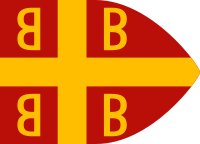This article should specify the language of its non-English content, using {{lang}}, {{transliteration}} for transliterated languages, and {{IPA}} for phonetic transcriptions, with an appropriate ISO 639 code. Wikipedia's multilingual support templates may also be used. (February 2024) |
| Byzantine army | |
|---|---|
 Imperial flag (basilikon phlamoulon) of the Palaiologan era (14th century) | |
| Leaders | Byzantine Emperor (commander-in-chief) |
| Dates of operation | c. 395–1453 |
| Headquarters | Constantinople |
| Active regions | Balkans, Asia Minor, Levant, Mesopotamia, Italy, Armenia, North Africa, Spania, Caucasus, Crimea |
| Part of | Byzantine Empire |
| Allies | Huns, Lombards, Armenians, Georgians, Serbs, Croats, Principality of Arbanon (Albanians), Crusader states, Anatolian beyliks, Khazars, Axum, Avars, Rus', Magyars, Heruli and others (intermittently) |
| Opponents | Goths, Huns, Sassanid Persia, Vandals, Ostrogoths, Avars, Slavs, Muslim Caliphate, Bulgaria, Rus', Normans, Albanians under House of Anjou-Durazzo, Armenians, Crusader states, Seljuks, Anatolian beyliks, Ottomans and others (intermittently) |
| Battles and wars | the wars of the Byzantine Empire |
| Part of a series on the |
| Byzantine army |
|---|
 |
| Structural history |
| Campaign history |
| Lists of wars, revolts and civil wars, and battles (Constantinople) |
| Strategy and tactics |
The Byzantine army was the primary military body of the Byzantine armed forces, serving alongside the Byzantine navy. A direct continuation of the Eastern Roman army, shaping and developing itself on the legacy of the late Hellenistic armies,[1] it maintained a similar level of discipline, strategic prowess and organization. It was among the most effective armies of western Eurasia for much of the Middle Ages. Over time the cavalry arm became more prominent in the Byzantine army as the legion system disappeared in the early 7th century. Later reforms reflected some Germanic and Asian influences[2]—rival forces frequently became sources of mercenary units, such as the Huns, Cumans, Alans and (following the Battle of Manzikert) Turks, meeting the Empire's demand for light cavalry mercenaries. Since much of the Byzantine military focused on the strategy and skill of generals utilizing militia troops, heavy infantry were recruited from Frankish and later Varangian mercenaries.
From the 7th to the 12th centuries, the Byzantine army was among the most powerful and effective military forces in the world – neither Middle Ages Europe nor (following its early successes) the fracturing Caliphate could match the strategies and the efficiency of the Byzantine army. Restricted to a largely defensive role in the 7th to mid-9th centuries, the Byzantines developed the theme-system to counter the more powerful Caliphate. From the mid-9th century, however, they gradually went on the offensive, culminating in the great conquests of the 10th century under a series of soldier-emperors such as Nikephoros II Phokas, John Tzimiskes and Basil II. The army they led was less reliant on the militia of the themes; it was by now a largely professional force, with a strong and well-drilled infantry at its core and augmented by a revived heavy cavalry arm. With one of the most powerful economies in the world at the time, the Empire had the resources to put to the field a powerful host when needed, in order to reclaim its long-lost territories.
After the collapse of the theme-system in the 11th century, the Byzantines grew increasingly reliant on professional Tagmata troops, including ever-increasing numbers of foreign mercenaries. The Komnenian emperors made great efforts to re-establish a native army, instituting the pronoia system of land grants in exchange for military service. Nevertheless, mercenaries remained a staple feature of late Byzantine armies since the loss of Asia Minor reduced the Empire's recruiting-ground, while the abuse of the pronoia grants led to a progressive feudalism in the Empire. The Komnenian successes were undone by the subsequent Angeloi dynasty, leading to the dissolution of the Empire at the hands of the Fourth Crusade in 1204.
The Emperors of Nicaea managed to form a small but effective force using the same structure of light and heavily armed troops, both natives and foreigners. It proved effective in defending what remained of Byzantine Anatolia and reclaiming much of the Balkans and even Constantinople itself in 1261. Another period of neglect of the military followed in the reign of Andronikos II Palaiologos, which allowed Anatolia to fall prey to an emerging power, the Ottoman Empire. Successive civil wars in the 14th century further sapped the Empire's strength and destroyed any remaining chance of recovery, while the weakening of central authority and the devolution of power to provincial leaders meant that the Byzantine army was now composed of a collection of militias, personal entourages and mercenary detachments.[3]
- ^ Dain, Alphonse (1930). Les Manuscrits d' Onésandros. Les Belles Lettres. OCLC 421178980.
- ^ Nicolle (1992), p. [page needed].
- ^ "Byzantine army : Who, What, Where, When". Archived from the original on 6 January 2011.